Text
FOTD #134 : mycena indigotica!
mycena indigotica (no common name) is a newly-discovered saprotrophic fungus in the family mycenaceae :-) it is currently only known to occur in northern taiwan, where it was first found.
the big question : can i bite it??
so far, the edibility is unknown.


m. indigotica description :
"basidiomata gregarious, not luminescent. pileus 1.5-3.5 mm diam, at first semiglobose, then convex to flattened, non-striate, pale blue… to blue… when young, gradually with black tints with age, totally black when old or in dried specimens, slightly pruinose when young, glabrous with age, context white, margin entire, crenulate. hymenophore consisting of 70-120 pores, pores circular, usually oval near stipe, concolourous with surface of pileus, 8-12 pores per mm. stipe 2e4 x 0.5e1 mm, blue… to dark blue… gradually with black tints with age, pruinose when young, glabrous with age, cylindrical, central, basally bulbous."
[images : source & source]
[fungus description : source]
410 notes
·
View notes
Text

AN EXTREMELY RARE EMBROIDERED 'PEACOCK FEATHER' CAPE
QING DYNASTY, LATE 19TH CENTURY
The long cape entirely constructed with layers of overlapping peacock feather shaped panels, each panel finely worked in satin stitch, the silk threads in tones of ivory, yellow and blue on the eye of the peacock feather, and the surround intricately worked in peacock feather filaments, with one cloth button on the collar and another near the waist, finished with Imperial yellow lining.
45 1/4 in.(115 cm) long
4K notes
·
View notes
Text
How Do I Make My Fictional Gypsies Not Racist?
(Or, "You can't, sorry, but…")
You want to include some Gypsies in your fantasy setting. Or, you need someone for your main characters to meet, who is an outsider in the eyes of the locals, but who already lives here. Or you need a culture in conflict with your settled people, or who have just arrived out of nowhere. Or, you just like the idea of campfires in the forest and voices raised in song. And you’re about to step straight into a muckpile of cliches and, accidentally, write something racist.
(In this, I am mostly using Gypsy as an endonym of Romany people, who are a subset of the Romani people, alongside Roma, Sinti, Gitano, Romanisael, Kale, etc, but also in the theory of "Gypsying" as proposed by Lex and Percy H, where Romani people are treated with a particular mix of orientalism, criminalisation, racialisation, and othering, that creates "The Gypsy" out of both nomadic peoples as a whole and people with Romani heritage and racialised physical features, languages, and cultural markers)
Enough of my friends play TTRPGs or write fantasy stories that this question comes up a lot - They mention Dungeons and Dragons’ Curse Of Strahd, World Of Darkness’s Gypsies, World Of Darkness’s Ravnos, World of Darkness’s Silent Striders… And they roll their eyes and say “These are all terrible! But how can I do it, you know, without it being racist?”
And their eyes are big and sad and ever so hopeful that I will tell them the secret of how to take the Roma of the real world and place them in a fictional one, whilst both appealing to gorjer stereotypes of Gypsies and not adding to the weight of stereotyping that already crushes us. So, disappointingly, there is no secret.
Gypsies, like every other real-world culture, exist as we do today because of interactions with cultures and geography around us: The living waggon, probably the archetypal thing which gorjer writers want to include in their portrayals of nomads, is a relatively modern invention - Most likely French, and adopted from French Showmen by Romanies, who brought it to Britain. So already, that’s a tradition that only spans a small amount of the time that Gypsies have existed, and only a small number of the full breadth of Romani ways of living. But the reasons that the waggon is what it is are based on the real world - The wheels are tall and iron-rimmed, because although you expect to travel on cobbled, tarmac, or packed-earth roads and for comparatively short distances, it wasn’t rare to have to ford a river in Britain in the late nineteenth century, on country roads. They were drawn by a single horse, and the shape of that horse was determined by a mixture of local breeds - Welsh cobs, fell ponies, various draft breeds - as well as by the aesthetic tastes of the breeders. The stove inside is on the left, so that as you move down a British road, the chimney sticks up into the part where there will be the least overhanging branches, to reduce the chance of hitting it.
So taking a fictional setting that looks like (for example) thirteenth century China (with dragons), and placing a nineteenth century Romanichal family in it will inevitably result in some racist assumptions being made, as the answer to “Why does this culture do this?” becomes “They just do it because I want them to” rather than having a consistent internal logic.
Some stereotypes will always follow nomads - They appear in different forms in different cultures, but they always arise from the settled people's same fears: That the nomads don't share their values, and are fundamentally strangers. Common ones are that we have a secret language to fool outsiders with, that we steal children and disguise them as our own, that our sexual morals are shocking (This one has flipped in the last half century - From the Gypsy Lore Society's talk of the lascivious Romni seductress who will lie with a strange man for a night after a 'gypsy wedding', to today's frenzied talk of 'grabbing' and sexually-conservative early marriages to ensure virginity), that we are supernatural in some way, and that we are more like animals than humans. These are tropes where if you want to address them, you will have to address them as libels - there is no way to casually write a baby-stealing, magical succubus nomad without it backfiring onto real life Roma. (The kind of person who has the skills to write these tropes well, is not the kind of person who is reading this guide.)
It’s too easy to say a list of prescriptive “Do nots”, which might stop you from making the most common pitfalls, but which can end up with your nomads being slightly flat as you dance around the topics that you’re trying to avoid, rather than being a rich culture that feels real in your world.
So, here are some questions to ask, to create your nomadic people, so that they will have a distinctive culture of their own that may (or may not) look anything like real-world Romani people: These aren't the only questions, but they're good starting points to think about before you make anything concrete, and they will hopefully inspire you to ask MORE questions.
First - Why are they nomadic? Nobody moves just to feel the wind in their hair and see a new horizon every morning, no matter what the inspirational poster says. Are they transhumant herders who pay a small rent to graze their flock on the local lord’s land? Are they following migratory herds across common land, being moved on by the cycle of the seasons and the movement of their animals? Are they seasonal workers who follow man-made cycles of labour: Harvests, fairs, religious festivals? Are they refugees fleeing a recent conflict, who will pass through this area and never return? Are they on a regular pilgrimage? Do they travel within the same area predictably, or is their movement governed by something that is hard to predict? How do they see their own movements - Do they think of themselves as being pushed along by some external force, or as choosing to travel? Will they work for and with outsiders, either as employees or as partners, or do they aim to be fully self-sufficient? What other jobs do they do - Their whole society won’t all be involved in one industry, what do their children, elderly, disabled people do with their time, and is it “work”?
If they are totally isolationist - How do they produce the things which need a complex supply chain or large facilities to make? How do they view artefacts from outsiders which come into their possession - Things which have been made with technology that they can’t produce for themselves? (This doesn’t need to be anything about quality of goods, only about complexity - A violin can be made by one artisan working with hand tools, wood, gut and shellac, but an accordion needs presses to make reeds, metal lathes to make screws, complex organic chemistry to make celluloid lacquer, vulcanised rubber, and a thousand other components)
How do they feel about outsiders? How do they buy and sell to outsiders? If it’s seen as taboo, do they do it anyway? Do they speak the same language as the nearby settled people (With what kind of fluency, or bilingualism, or dialect)? Do they intermarry, and how is that viewed when it happens? What stories does this culture tell about why they are a separate people to the nearby settled people? Are those stories true? Do they have a notional “homeland” and do they intend to go there? If so, is it a real place?
What gorjers think of as classic "Gipsy music" is a product of our real-world situation. Guitar from Spain, accordions from the Soviet Union (Which needed modern machining and factories to produce and make accessible to people who weren't rich- and which were in turn encouraged by Soviet authorities preferring the standardised and modern accordion to the folk traditions of the indigenous peoples within the bloc), brass from Western classical traditions, via Balkan folk music, influences from klezmer and jazz and bhangra and polka and our own music traditions (And we influence them too). What are your people's musical influences? Do they make their own instruments or buy them from settled people? How many musical traditions do they have, and what are they all for (Weddings, funerals, storytelling, campfire songs, entertainment...)? Do they have professional musicians, and if so, how do those musicians earn money? Are instrument makers professionals, or do they use improvised and easy-to-make instruments like willow whistles, spoons, washtubs, etc? (Of course the answer can be "A bit of both")
If you're thinking about jobs - How do they work? Are they employed by settled people (How do they feel about them?) Are they self employed but providing services/goods to the settled people? Are they mostly avoidant of settled people other than to buy things that they can't produce themselves? Are they totally isolationist? Is their work mostly subsistence, or do they create a surplus to sell to outsiders? How do they interact with other workers nearby? Who works, and how- Are there 'family businesses', apprentices, children with part time work? Is it considered 'a job' or just part of their way of life? How do they educate their children, and is that considered 'work'? How old are children when they are considered adult, and what markers confer adulthood? What is considered a rite of passage?
When they travel, how do they do it? Do they share ownership of beasts of burden, or each individually have "their horse"? Do families stick together or try to spread out? How does a child begin to live apart from their family, or start their own family? Are their dwellings something that they take with them, or do they find places to stay or build temporary shelter with disposable material? Who shares a dwelling and why? What do they do for privacy, and what do they think privacy is for?
If you're thinking about food - Do they hunt? Herd? Forage? Buy or trade from settled people? Do they travel between places where they've sown crops or managed wildstock in previous years, so that when they arrive there is food already seeded in the landscape? How do they feel about buying food from settled people, and is that common? If it's frowned upon - How much do people do it anyway? How do they preserve food for winter? How much food do they carry with them, compared to how much they plan to buy or forage at their destinations? How is food shared- Communal stores, personal ownership?
Why are they a "separate people" to the settled people? What is their creation myth? Why do they believe that they are nomadic and the other people are settled, and is it correct? Do they look different? Are there legal restrictions on them settling? Are there legal restrictions on them intermixing? Are there cultural reasons why they are a separate people? Where did those reasons come from? How long have they been travelling? How long do they think they've been travelling? Where did they come from? Do they travel mostly within one area and return to the same sites predictably, or are they going to move on again soon and never come back?
And then within that - What about the members of their society who are "unusual" in some way: How does their society treat disabled people? (are they considered disabled, do they have that distinction and how is it applied?) How does their society treat LGBT+ people? What happens to someone who doesn't get married and has no children? What happens to someone who 'leaves'? What happens to young widows and widowers? What happens if someone just 'can't fit in'? What happens to someone who is adopted or married in? What happens to people who are mixed race, and in a fantasy setting to people who are mixed species? What is taboo to them and what will they find shocking if they leave? What is society's attitude to 'difference' of various kinds?
Basically, if you build your nomads from the ground-up, rather than starting from the idea of "I want Gypsies/Buryats/Berbers/Minceiri but with the numbers filed off and not offensive" you can end up with a rich, unique nomadic culture who make sense in your world and don't end up making a rod for the back of real-world cultures.
3K notes
·
View notes
Text
y'all ever reach the end of google
71K notes
·
View notes
Text
A Workshop for Creating Magical/ Fictional Crystals: A Guide from a Geologist
Hi folks, its me, here to talk about fictional writing again! Today I'm just tackling the idea of magical stones/mana stones by looking at existing minerals today and some neat properties that they have, and how you can apply these things to a fictional world. The goal is mainly to help you if you are stuck trying to come up with a unique magic system, or a unique identification/characteristic of your mineral.
First Things First: Mineral Shapes

I am exhausted, petered out, down-right fatigued by seeing every mineral depicted with having the crystal structure of calcite and quartz. There are soooooo many cooler, more interesting crystal structures, don't you think you would stop and take a look at a perfect cube in nature? It is completely unsettling.
Second: Color
Color within minerals can either be really important, or not important at all! It is your choice to decide if color is going to be something that means something to your mineral. But what are some times when the color is important? Well.... there are some elements that are called chromophores, this classification just indicates that these elements, when present, will determine the color of whatever they are in. So, if you wanted to treat mana like a chromophore, you could say, "Oh everything that contains mana turns green!" This could mean that regardless of the mineral, if that mineral is a specific color, it means it contains mana. This concept is exciting because you can just stop here and use minerals that already exist! You can also use it as an indicator for a magical ore! Chromophores are typically metals, so if you are making a new metal weapon, making the ore of that metal a unique color would make a lot of sense!
However, your mineral can also just be every color of the rainbow like quartz and perhaps that's what makes identifying your mana stones elusive and create an illusion of scarcity that your character can solve.

There are other things that can change the colors of minerals, like radiation damage, and electron exchange, but I think that is beyond what would be helpful! So lets talk about some unique color properties that happen in nature that seem magical in the first place! Maybe you don't need to design a mana stone, but you want a unique gemstone that only the royal family passes down or something (IDK).
The first one is the alexandrite effect! This is where a mineral can change color in natural light vs. incandescent light. (the mineral itself is not changing, but the lights contain different amounts of different colors that then get absorbed by the stone). Even if you don't use electricity in your fictional world, you could have the colors change in the presence of light magic. This could create fun misunderstandings about what the mineral is reacting to!
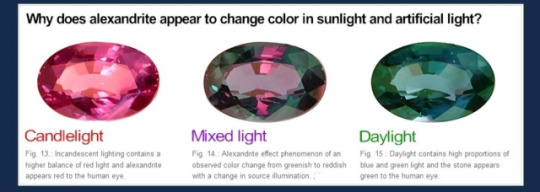
Pleochroism
Pleochroism is something that most minerals have, it is frequently used to help identify minerals in thin sections, however minerals are usually not pleochroic enough for it to be visible to the naked eye! Pleochroism is just a fancy name to describe the change in how light is absorbed based on the angle of the mineral! So if you scroll up to the first image where I showed a lot of crystal shapes, most of them have angles where they are longer and shorter! This will effect the way light travels in the crystal. Tanzanite is a popular mineral that does this.

Photochromism
This is when a mineral will change color (in a reversible way) when exposed to UV light (or sunlight), I am not going to go too into the details of why this is happening because it would require me to read some research papers and I just don't feel like it. The mineral that is best known for this is Hackmanite!

Alright! These are all the really cool color effects that might inspire you or maybe not, but now I am going to talk about how you might find your minerals within a rock!
When I see a lot of magical caves/mines, typically I see them with some variation of a geode honestly, but most minerals are not found like that! Now I am sure most of you guys have seen a geode, so I will not really talk about those, but I will talk briefly about porphyroblasts which is when the mineral grows larger than the minerals around it, this happens in metamorphic minerals!

sorry random stranger, but this is an image of garnets inside a finer-grained rock at gore mountain in New York!
Another way you might find minerals is in a pegmatite! This is when all minerals are really large! This is a formed from really slow crystalizing magma!
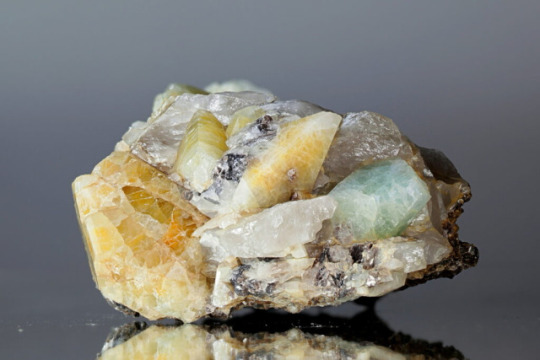

But something else to think about is that your mineral might just be massive, it doesn't have to have distinct crystals, it may be similar to jadeite where small grains grow together which leaves it looking smooth and seamless! A note about all of these is that you would have to mine into the rock to find these, there would not be any natural caves in these rocks! Caves are only ever really formed in limestones and maybe marbles (rocks that react with acid).

How can your characters identify these minerals?
Typically when you are out in the field you will look to see what type of rocks the minerals are found in (The overall texture of the rock will tell you how it formed). If you know how the rock formed, it will narrow down the amount of minerals you need to think about by quite a bit! Next, you are going to look closely at it and observe its crystal structure, does it have an obvious crystal? if so what is the general shape? If it is broken, how did it break? Did it fracture like glass or did it break along uniform planes. Some minerals have a thing called cleavage (breaks along planes of weakness). If a mineral exhibits this habit, it will again help narrow this down. Next we can look at color. Color can be misleading, because minerals like quartz can be any color imaginable, but minerals like olivine will always be green! The next thing your character can do is test for hardness, minerals all have a specific hardness that can help identify it as well.
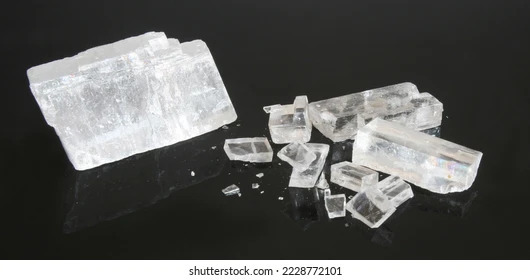
After you go through all of this, your mineral might have some special property! This could be magnetism, fluorescence, reactions to acid, or any of the color changing effects I mentioned above! Other than that, your character can take it back to a lab and do a number of things to identify it, but the most typical thing would be for them to make a thin section (very thin piece of the rock) and observe it under a cross polarized microscope!

On that note folks! I hope this helped in some way in thinking of new magic mineral properties! I have other guides that explore some different fictional worldbuilding issues you might run into, but if you have any topics you would like me to cover please that I haven't mentioned already, let me know!
4K notes
·
View notes
Text
This is a redraw of this previous post!


Rhoek of the Red Fig
"There are no, no good wardens. If there ever were, they didn’t stay that way, one way or, or the other."
To an outsider, he is an enigma. He is a member of a sour clan, and yet once stood as a clothwarden of Calderix. He threw that privilege away, his apparent "weakness" allowing him out alive but condemning him to a life walking on eggshells around his former comrades, but he willingly remains in Calderix. Despite all odds, he clearly thrives, though what goes on in his life remains a mystery to most. His loyalty to those who deserve it is unbreaking, and his brother Kip knows that Rhoek is the one person who will never abandon him.
Rhoek is a mature adult Xareli werdrake. He left his surclan before the event that put his brother Kip in such low standing, but ended up the same anyway after the mixed-blood (or "sour") pack he ran with became his clan. He and his clan seem to live in Calderix’s grand haven, Sareld, but few know exactly where. His hoard focus is shiny metal, and though many low-caste Calderians avoid adorning themselves further with the silvery colors associated with Xarelei, he seems to flaunt it.
2 notes
·
View notes
Text


Rhoek of the Red Fig
"There are no, no good wardens. If there ever were, they didn’t stay that way, one way or, or the other."
To an outsider, he is an enigma. He is a member of a sour clan, and yet once stood as a clothwarden of Calderix. He threw that privilege away, his apparent "weakness" allowing him out alive but condemning him to a life walking on eggshells around his former comrades, but he willingly remains in Calderix. Despite all odds, he clearly thrives, though what goes on in his life remains a mystery to most. His loyalty to those who deserve it is unbreaking, and his brother Kip knows that Rhoek is the one person who will never abandon him.
Rhoek is a mature adult Xareli werdrake. He left his surclan before the event that put his brother Kip in such low standing, but ended up the same anyway after the mixed-blood (or "sour") pack he ran with became his clan. He and his clan seem to live in Calderix’s grand haven, Sareld, but few know exactly where. His hoard focus is shiny metal, and though many low-caste Calderians avoid adorning themselves further with the silvery colors associated with Xarelei, he seems to flaunt it.
2 notes
·
View notes
Text
It is just me, or would it be easier to genetically engineer more plants to have similar yields as the dominant crops, rather than genetically engineer the dominant crops to be resistant to all conditions and challenges? The former involves manipulating relatively few genes, while the latter involves as yet unknown processes that may not even work.
The issue is funding. But we made that up, so surely we can get around it.
2K notes
·
View notes
Text
Geology of Natural Disasters and How to write them into your fictional universe.
So, you want to write about a natural disaster to advance your plot and torture your players/characters even more? Let me tell you how, accurately.
I feel like unless it is a volcano, natural disasters are a pretty slept on plot drivers, and some of them are really cool and unique! Today, I will talk to you about land slides, earthquakes (And earthquake related disasters), and volcanoes.
Landslides: Probably one I see the least in stories, but one that would be incredibly interesting to write into a plot where they believe in curses. Landslides can happen along ocean bluffs, slightly hilly areas, and highly mountainous areas, this means it is something that can happen in most landscapes. But what can trigger a landslide? Mostly all you need to trigger a landslide could be just abnormally large amounts of rain, excessive deforestation (with a little bit of rain), or an earthquake. If you don't want to use deforestation or an earthquake as a catalyst, a really cool indicator that the land is slipping and may be prone to a collapse is J hooked trees.

This indicates that there is soil creeping slowly over time, and it may lead to a major landslide.
2. Earthquakes: Probably one of the easiest things to write, earthquakes can happen anywhere, but they are most common in places that are tectonically active areas. There are about three types of environments you can expect earthquakes to be common. The first is just rugged mountains, if your landscape looks like this, you should write in earthquakes. Associated hazards could be landslides, avalanches, and large falling rocks.
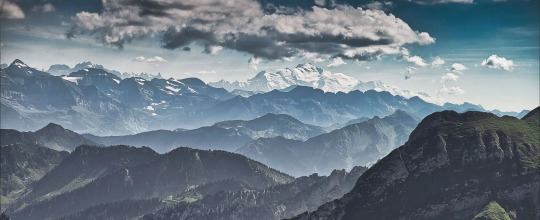
The next landscape could be a thin mountain range, next to the ocean, very scenic, but very dangerous. Essentially, I am describing a subduction zone environment.

Earthquakes in these areas could equal a couple different associated disasters. Scenario one: A very large earthquake happens, and the ocean begins to recede. This is a tsunami, enough said. If you are writing a tsunami though, please, please, do not write it as a large wave, thank you. Also, a common way people are hurt by tsunami's are from them going into the ocean because they don't understand a tsunami is going to happen.
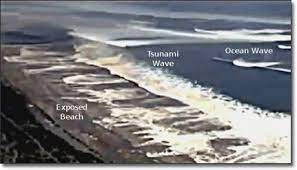
Scenario two: A large earthquake happens, your characters are in a valley and suddenly the ground begins to liquify as the ground shakes, once the shaking stops, the ground becomes solid like nothing ever happened, except everything has suddenly sunk into the now hard ground. This is called liquefaction and it typically happens in areas that have loose dirt or lots of saturated soil.
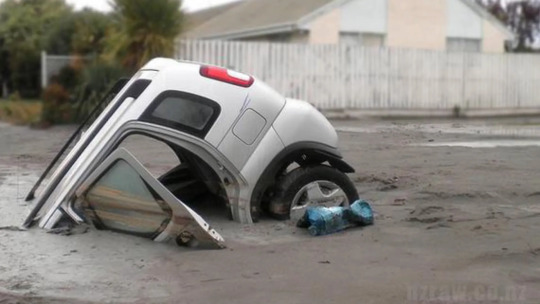
Scenario three: There are a lot of small earthquakes, they do not cause a lot of damage, but you begin to notice that one of the isolated mountains has a plume rising. Earthquakes can indicate lava moving underground and the filling of magma chambers.
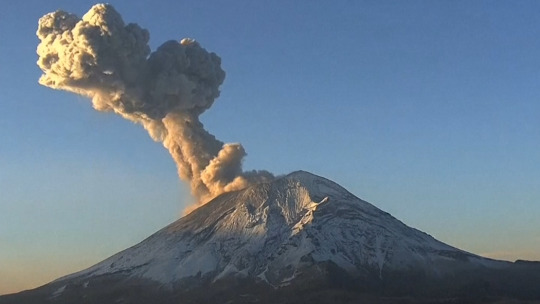
The next environment that can host lots of earthquakes would be regions that have a lot of really deep valleys and small mountain ranges (not cone volcanoes), but overall seems pretty flat.
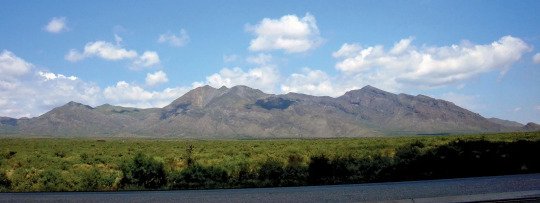
This indicates a transform fault like the San Andreas. If you want to hint at there being earthquakes in the area, you can show fence posts that are suddenly several feet out of line at a dilapidated farm or something similar.
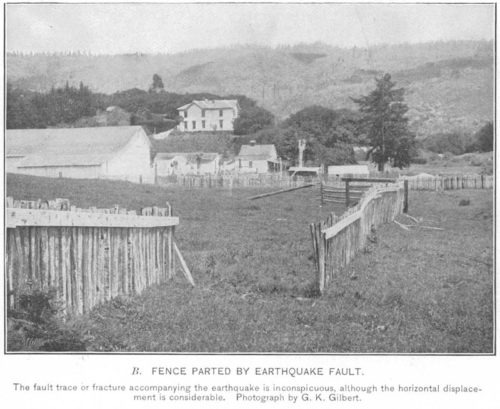
(These earthquakes are different because they are cased from sideways movement, not an up-and-down movement this hint can only be used for this environment). Volcanoes would not be found here, but liquefaction and landslides could still occur here.
4. Volcanoes: If you thought earthquakes had a lot of information, volcanoes do too. First you have to ask yourself, what kind of volcano you want to have, what kind of eruption style? So lets break down the kind of eruptions you can have and what their landscapes look like. Hawaiian Shield volcano: This will produce a smooth fast lava, the landscape typically is pretty flat, but there will be small cones and the rocks can have a ropey or jagged texture and the rocks will be almost exclusively black to dark red.

Stratovolcanoes: These will be solitary mountains, typically, that look like perfect cones (Picture shown in earthquake section). These will have large ash cloud eruptions and pyroclastic flows, they may have some lava, but typically most damage is done from the pyroclastic flows (think Pompeii). Some hints of these, other than describing the cone features (which can be hidden by other mountains), would be to talk about petrified wood! Trees can get fossilized in the ash and I imagine it would be very strange to find this rock that clearly looks to be a piece of wood, but its a rock. Subcategory- Calderas: Used to be a large stratovolcano, but they erupt so explosively that the entire cone collapses and creates a basin.

There are a lot of kinds of volcanoes out there, so forgive me for just putting an infographic and then talking to you about these really rare types of eruptions that I feel like people should know about.
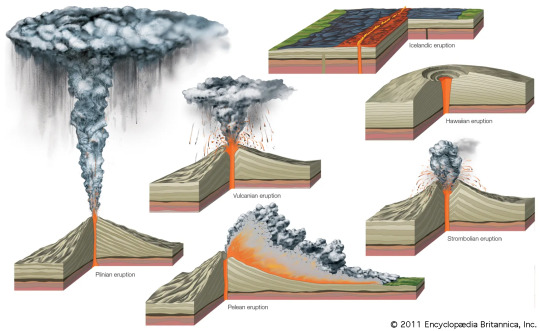
Okay lets talk about blue lava (kind of) and black lava

You will notice the lava is still red in the middle of this image, during the day these would look like a normal eruption, but at night the burning sulfur would make it appear blue. Some cool features other than this, would be that any water in the area would become very acidic and burn the skin due to sulfuric acid. This would again be really cool if you are trying to describe a 'cursed' land.
Black lava: This happens only in the east African rift I believe, but it is a carbonatite lava, but if you are writing in a rift valley (where the continent is tearing apart to form a new ocean) this might be a cool feature. The lava will cool white and will quickly erode, it makes for a very alien landscape!

Anyway as always, this is supposed to be an introductive guide for the basics of writing geology to create cool landscapes/features into dnd or fictional universes, if you are a geologist please understand my oversimplification of tectonics, I didn't want people to run away.
4K notes
·
View notes
Note
Do you have any ideas about how Solarpunk would take effect in areas with cold and snowy climates for most of the year? Or have you seen any posts about that topic? My only thoughts are the adoption of ponchos/cloaks instead of coats, because they can easily be passed from person to person. Most people around here garden and farm when they can, but with winter/cold weather taking hold for 5 months a year, the growing season is short.
I have seen a lot of solarpunks ask about wintery/snowy areas, and I have seen a few posts about it in the solarpunk tags. Here are some things I’ve collected for you:
Whittier, Alaska is a town where everyone lives in one big building. This is a great idea in itself, and I feel like you could play with it a little more. It’s a great way to maintain a community, and I imagine it would also maintain a low environmental impact. Underground cities would also follow along those lines.
Jumping off of that, indoor farming. This farm boasts better productivity than conventional farming! That would be a perfect thing to have in your one-building town, or any town really.
In places where the sun isn’t seen most of the year, solar energy won’t be of much use, so the main energy creation modes would be wind, waves, and human motion, with algae for light.

Speaking of light, I think lights would play a big part of the fashion in places where the sun shines infrequently.


Even incorporate it into accessible design
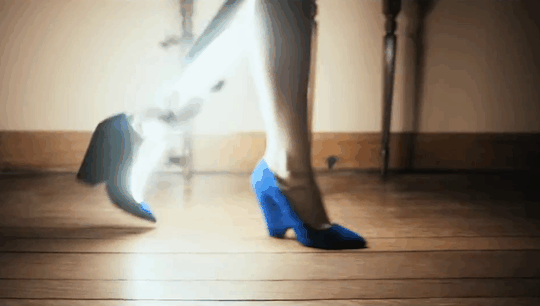
Or perhaps the citizens could celebrate the surroundings they have, and wear nighttime inspired clothes.

And if they celebrate their environment, of course ice would be included

This post has a lot of important notes about solarpunk fashion that apply here.
Just a few things to get you started on your own ideas. Hope this helps!
1K notes
·
View notes
Text
Alligator Body Language and You, or: How To Know When An Alligator On Social Media is Being Stressed for Views
Alligators are wild animals. Despite the idiotic claims of animal abusers like Jay Brewer, they cannot be domesticated, which means they are always going to react on the same natural instincts they've had for millions of years. Habituated, yes. Tamed, yes. Trained, definitely. Crocodilians can form bonds with people- they're social and quite intelligent. They can solve problems, use tools, and they're actually quite playful. Alligators are also really good at communicating how they're feeling, but to somebody who doesn't spend much time around them, their body language can be a bit mystifying. And it doesn't help when social media influencers are saying shit like this:

That is not what a happy gator looks like.
That's a terrified, furious gator who isn't attacking because the ogre handling her has her in a chokehold. She's doing everything she can to express her displeasure, and he's lying about it because he knows his audience doesn't even know how to think critically about what he's doing. He knows that because his audience doesn't know anything about these animals, he can get away with it. This I think is why I hate him so much- he deliberately miseducates his audience. He knows what he's doing is factually inaccurate, he just doesn't care because attention means more to him than anything else in the world.
Let's change that! Here are two really important lessons for understanding alligator body language on social media.
Lesson 1: Alligators Don't Smile (in fact, most animals don't)
So what's going on in this video? Jay Brewer is aggressively choking his white alligator Coconut while scrubbing algae off of her with a toothbrush. And make no mistake, he is digging into the creature's throat while she is visibly distressed. He claims she's happy- but she's not. He is willfully misrepresenting what this animal is feeling. That's a problem, because people... well, we actually kind of suck at reading other species' body language. The reason for this is that we tend to overlay our own responses on their physical cues, and that's a problem. For example, let's look at an animal with a really similar face to ours, the chimpanzee. Check out Ama's toothy grin!
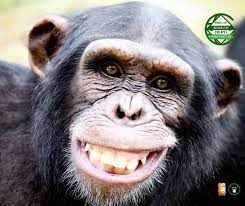
Wait, no. That's not a happy smile. That's a threat display. When a chimpanzee "smiles," it's either terrified and doing a fear grimace, or it's showing you its teeth because it intends on using them in your face.
How about a dog? Look at my smiling, happy puppy!

Oh wait no, this is a picture of Ryder when he was super overwhelmed by noise and people during a holiday party. He'd hopped up in my sister's lap to get away from stuff that was happening on the floor and was panting quite heavily. See the tension in the corners of his mouth and his eyes? A lot of the time when a dog "smiles," the smile isn't happy. It's stress! Why Animals Do The Thing has a nice writeup about that, but the point is, our body language is not the same as other species. And for reptiles, body language is wildly different.
For instance, look at these two alligators. Pretty cute, right? Look at 'em, they're posing for a Christmas card or something! How do you think they're feeling?

Well, I'll tell you how the normal one is feeling. He's annoyed! Why is he annoyed? Because the albino just rolled up, pushed another gator off the platform, and is trying to push this guy, too. I know this because I actually saw it happen. It was pretty funny, not gonna lie. He's not gaping all the way, but he was hissing- you can actually see him getting annoyed in the sequence I took right before this shot. Look at him in this first shot here- he's just relaxing, and you can see he isn't gaping even a little bit.


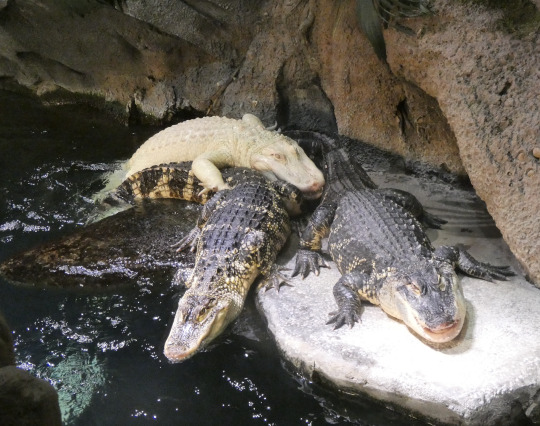
By the end, he's expressing displeasure, but not enough to actually do anything about it. He's annoyed, but he's comfy and that's where one of the best basking areas is, so he'll put up with it.
Reptiles open their mouths wide for a lot of reasons, but never because they are actively enjoying a sensation. Unless they're eating. No reptile smiles- they can't. They don't even have moveable lips. If a reptile is gaping, it's doing so because:
It is doing a threat display.
It is making certain vocalizations, all of which are threats. Alligators are one of the rare reptiles that do regularly vocalize, but most of their calls aren't made with a wide open mouth.
It is about to bite something delicious or somebody stupid. Check out this video- virtually all of the gaping here is anticipatory because these trained gators know darn well that the bowl is full of delicious snacks. (I have some issues with Florida's Wildest, but the man knows how to train a gator AND he is honest about explaining what they're doing and why, and all of his animals are healthy and well-cared for, and he doesn't put the public or his staff at risk- just himself.)
youtube
It's too hot and it has opened its mouth to vent some of that heat and thermoregulate. This is the main reason why alligators will often have their mouths part of the way open, but sometimes they'll open all the way for thermoregulation. This is what a thermoregulatory gape looks like- usually it's not all the way open, kinda more like < rather than V, but you can't say that 100% of the time. Additionally, a thermoregulatory gape... typically happens when it's hot out. If they're inside, maybe they've been under their basking light for too long. Heat's the dominant factor, is what I'm getting at.
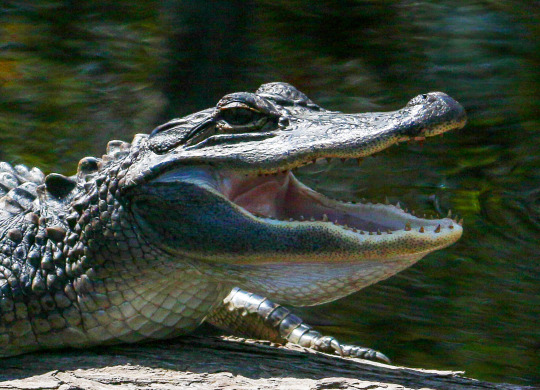
There is another reason that a captive crocodilian might be gaping, and that's because it's doing so on command. Some places have their gators trained to gape on cue, like St. Augustine Alligator Farm and other good zoos. They have the animals do this in presentations that are genuinely educational. They ask the animals to open their mouths so that they can show off their teeth and demonstrate how their tongues seal off the back of their mouth. They'll also do it as part of routine healthcare, because looking at their teeth is important.
In this case, the animals aren't gaping because they're stressed, they're gaping because they know they're gonna get a piece of chicken or fish if they do it. And what's more, they're doing it on cue. They have a specific command or signal that tells them to open wide. It's not an instinctive response to a situation. It's trained. If the animal provides the behavior after a cue, the situation is much less likely to be negatively impactful.
It's also important to remember that there's a difference between a partially open mouth and a gape! As discussed above, alligators will often have their mouths a little bit open just to maintain temperature homeostasis. It helps them stay comfy, temperature-wise. These guys are all doing thermoregulatory open-mouthed behavior- that slight open and relaxed body posture is a dead giveaway. (That and it's the hottest spot in the enclosure.)
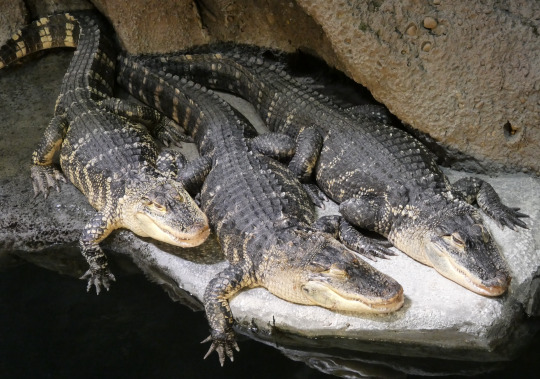
Lesson 2: A Happy Gator Is A Chill Gator
So if alligators don't smile or have facial expressions other than the :V that typically signifies distress, how else can you tell how they're feeling? One way is stillness. See, alligators subscribe to the philosophy of if it sucks... hit da bricks.
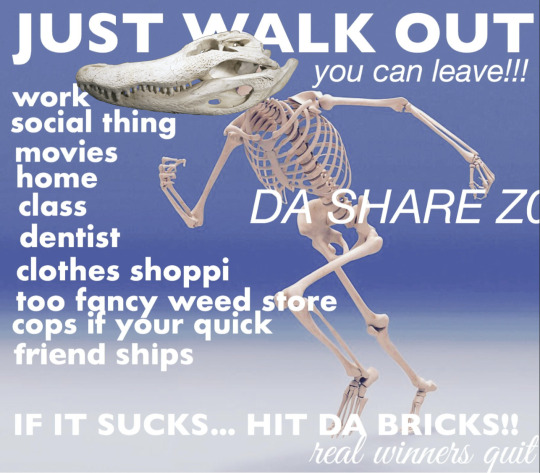
Basically, if they hate it, they'll leave. Unless, y'know, somebody has their meaty claws digging into their throat or is otherwise restraining them. (Restraint isn't always bad, btw. Sometimes the animal is going through a medical thing or needs to be restrained for their safety- which a responsible educator will explain.)
Let's look at a very similar scenario, in which a captive alligator is getting his back scrubbed.
As you can see, it's quite different. First, he's not being restrained at all. Second, look at how relaxed he is! He's just chilling there vibing! He could simply get up and leave if he wanted to, because he's not being held. Towards the end of the video, as he lifts his head, you can see that his respiratory rate is very even as his throat flutters a bit. I'm not sure what this facility is, so I can't comment on care/general ethics, but like. In this specific case, this is an alligator enjoying being scrubbed! And you can tell because he's not doing anything. A happy gator is content to be doing what they're doing.
Why Should I Listen To You?
Now, you should ask yourself, why should you listen to me? Why should you trust me, who does not own an alligator, versus Jay Brewer, who owns several?
Well, first off, there's no profit for me in telling you that what you're seeing on social media is in fact not what you're being told you're seeing. I'm not getting paid to do this. That's the thing with people who make social media content. The big names aren't doing it just for fun. They're doing it for money. Whether that's profit through partnerships or sponsorships, or getting more people to visit their facilities, or ad revenue, you can't ignore the factor of money. And this is NOT a bad thing, because it allows educators to do what they're passionate about! People deserve to be paid for the work that they do!
But the problem starts when you chase the algorithm instead of actually educating. A "smiling" alligator gets the views, and if people don't know enough to know better, it keeps getting the views. People love unconventional animal stories and they want those animals to be happy- but the inability to even know where to start with critically evaluating these posts really hinders the ability to spread real information. Like, this post will probably get a couple hundred notes, but that video of Coconut being scrubbed had almost 400,000 likes when I took that screenshot. Think about how many eyeballs that's reached by now. What I'm saying here is that it's just... really important to think critically about who you're getting your information from. What do dissenters say in the comments? What do other professionals say? You won't find a single herpetologist that has anything good to say about Prehistoric Pets, I can tell you that right now.
Another reason you can trust me is that my sources are not "just trust me bro," or "years of experience pretending my pet shop where animals come to die is a real zoo." Instead, here are my primary sources for my information on alligator behavior:
Dragon Songs: Love and Adventure among Crocodiles, Alligators, and Other Dinosaur Relations- Vladimir Dinets
The Secret Social Lives of Reptiles- J. Sean Doody, Vladimir Dinets, Gordon M. Burghardt
Social Behavior Deficiencies in Captive American Alligators (Alligator mississippiensis)- Z Walsh, H Olson, M Clendening, A Rycyk
Social Displays of the American Alligator (Alligator mississippiensis)- Kent Vliet
Social Signals and Behaviors of Adult Alligators and Crocodiles- Leslie Garrick, Jeffery Lang
Never smile at a crocodile: Gaping behaviour in the Nile crocodile at Ndumo Game Reserve, South Africa- Cormac Price, Mohamed Ezat, Céline Hanzen, Colleen Downs (this one's Nile crocs, not American alligators, but it's really useful for modeling an understanding of gape behaviors and proximity)
Thermoregulatory Behavior of Captive American Alligators (Alligator mississippiensis)- Cheryl S. Asa, Gary D. London, Ronald R. Goellner, Norman Haskell, Glenn Roberts, Crispen Wilson
Unprovoked Mouth Gaping Behavior in Extant Crocodylia- Noah J. Carl, Heather A. Stewart, Jenny S. Paul
Thank you for reading! Here's a very happy wild alligator from Sanibel for your trouble.

33K notes
·
View notes
Text
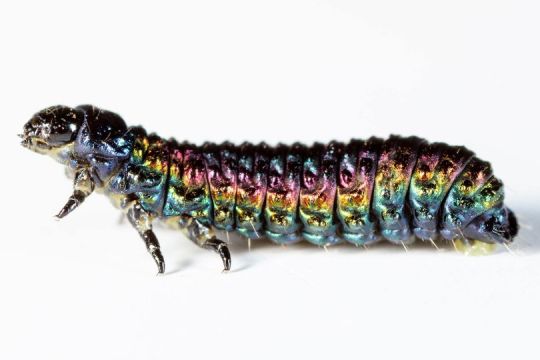
Groundselbush Beetle (Trirhabda bacharidis), larva, family Chrysomelidae, Jacksonville, Florida, USA
photograph by Efram Goldberg
7K notes
·
View notes
Text
birds have truly mastered feathers like what do you Mean they can be shiny. how fucking cool is that
59K notes
·
View notes
Text
“cyberpunk future where you need to make payments on your cybernetics or they get repo’d” is good, but doesn’t go far enough. consider cyberpunk future where the terms of service restrict how you can use your augments and implants — your prosthetic hands physically quake and lock up if you try to use them for things your medical company deems “a risk factor” (which somehow includes protesting the very same biomedical conglomerate), and your eyes automatically blur information that tells you how to improve or update augments yourself. but even surrounded by this much greed, widespread underground communities exist of people helping one another jailbreak their titanium bodies, recapturing the autonomy corporations have methodically stripped away from them.
19K notes
·
View notes
